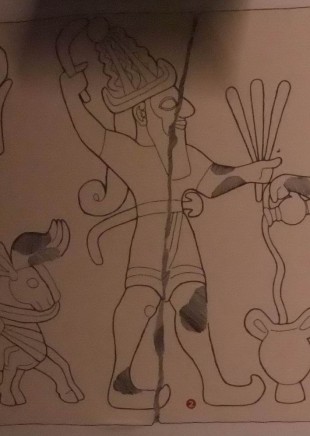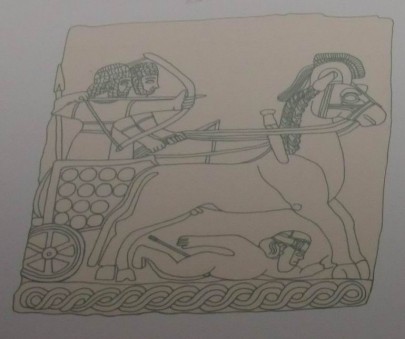End of the Ankara’s visit Museum

There is a big collection of magnificent bas-relief of Neo-Hittite period
Il y a une grande collection de bas-relief magnifique de la période Néo-Hittite
Orthostat, Limestone, Aslantepe, Malatya. Neo-Hittites
Orthostat, Calcaire, Aslantepe, Malatya. Néo-Hittites

Let’s go! Here is a small possible description, thanks to the very well made explanatory notice …
Feel reassured I wouldn’t make it for every bas relief!
Allez ! Voici une petite description, possible grâce aux panneaux explicatifs très bien faits…
Rassurez-vous je ne le ferais pas pour tous les bas-reliefs !

 God facing right, bearded and with long, curled pig tail, wearing pointed, horned helmet, short sleeved, belted, bordered tunic and boots with upturned toes, curve sword, with crescent pommels in belt, holding in right hand raised behind him boomerang (?), in hand left held before him a 3 pronged object.
God facing right, bearded and with long, curled pig tail, wearing pointed, horned helmet, short sleeved, belted, bordered tunic and boots with upturned toes, curve sword, with crescent pommels in belt, holding in right hand raised behind him boomerang (?), in hand left held before him a 3 pronged object.
Le Dieu qui montre sa face droite, barbu et avec une longue queue de porc bouclée, porte un casque pointu, cornu, des manches courtes, une ceinture, une tunique aux bords marqués et des bottines avec des orteils retournés, une épée courbée, avec des pommeaux de croissant dans la ceinture, il tient dans la main droite levée derrière lui un boomerang (?), dans la main laissée devant lui il tient un objet à 3 dents.
 A similarly accou tred god, facing right, in a two wheeled cart, with body in form of a bird, drawn by 2 harnessed bulls (figures 1 and 2 presumably repre sent the same god, first driving up then arrived)
A similarly accou tred god, facing right, in a two wheeled cart, with body in form of a bird, drawn by 2 harnessed bulls (figures 1 and 2 presumably repre sent the same god, first driving up then arrived)
Dieu de la même façon équipé, faisant face côté droit, dans un chariot à deux roues, avec le corps en forme d'oiseau, tiré par 2 taureaux harna- hés (les figures 1 et 2 représentent vraisemblablement sont le même Dieu, d'abord conduisant puis arrivé)
 Bare-headed, beardless man, with hair curled up on forehead and nape of neck, facing left wearing long, fringed garment, and shoes with upturned toes, holding in his right hand a jug form which he pours a libation into a 2 handled bowl on the ground, in his left hand a lituus (In the antiquity: a stick with butt) pointing back and downwards.
Bare-headed, beardless man, with hair curled up on forehead and nape of neck, facing left wearing long, fringed garment, and shoes with upturned toes, holding in his right hand a jug form which he pours a libation into a 2 handled bowl on the ground, in his left hand a lituus (In the antiquity: a stick with butt) pointing back and downwards.
L'homme nu-tête, sans barbe, avec des cheveux bouclé sur le front et la nuque, faisant face du côté gauche, porte un vêtement à franges et des chaussures avec des orteils retournés, il tient dans sa main droite une cruche, il verse une libation dans un bol à 2 poignets posé sur le sol, dans sa main gauche un lituus (dans l’antiquité : un bâton à crosse) dirigé vers l’arrière et vers le bas.
Behind him facing left, small bare-headed, beardless attendant holds a bull.
Derrière lui de face gauche, un petit préposé nu-tête, sans barbe tient un taureau.


Here are some the others bas relief; without comments.
Voici quelques autres bas relief ; sans commentaires.

Half-man and half-animal / Mi-homme et mi-animal

Small chaps jokers! / Petits bonhommes rigolards !



A religious ceremony / Une cérémonie religieuse

There are three women walking in long dress and high headdresses. It is believed that they are the priestess of the Goddess Kubaba. In the right hand of one of the figures is a small animal, and in the right hand of the figure in the middle, a goblet. It is not clear that they have in their left hands.

Il y a trois femmes marchant, habillées de longues robes et coiffées de coiffures hautes. On croit qu'elles sont les prêtresses de la Déesse Kubaba. Dans la main droite d'une des femmes se trouve un petit animal, celle du milieu tient un gobelet dans la main droite. Ce qu’elles tiennent dans leurs mains gauches n’est pas défini.

There are three women walking in long dress and high headdresses. It is believed that they are the priestess of the Goddess Kubaba. The figures in the front and at the back hold ear of grains in their right hand. The right hand of the middle figure is empty. They each carry a staff-like object in their left hands.

Il y a trois femmes marchant, habillées de longues robes et coiffées de coiffures hautes. On croit qu'elles sont les prêtresses de la Déesse Kubaba.
La première et la dernière des femmes tiennent un épis de grains dans leur main droite. Celle du milieu n’a rien dans sa main droite. Chacune porte le même un objet dans leurs mains gauches.
While one of the figures in the chariot pulls the rein, the other shoots an arrow. Beneath the horse is a naked figure lying face down with an arrow in his hip. This figure is depicted smaller, hence may represent an enemy soldier. The lower part of bas relief is decorated with a guilloche pattern.


Tandis qu'un des personnages dans le char tient les rênes, l'autre tire une flèche. Au-dessous du cheval un personnage nu la face contre terre, avec une flèche dans sa hanche. Ce personnage est dépeint plus petit, il peut représenter un soldat ennemi.
La partie inférieure du bas-relief est décorée d'un modèle de guillochis.
A last photo before leaving this magnificent museum!
Une dernière photo avant de quitter ce magnifique musée !
